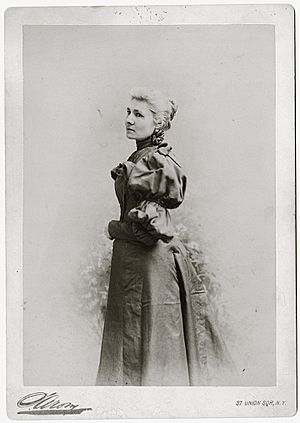Helen P. Clarke facts for kids
Quick facts for kids
Helen P. Clarke
|
|
|---|---|

Portrait of Clarke by Napoleon Sarony, c. 1895
|
|
| Born | 1846 The mouth of the Judith River, Montana
|
| Died | March 4, 1923 |
| Nationality | Piegan Blackfeet and American |
Helen Piotopowaka Clarke (1846 – March 4, 1923) was an amazing woman who made history in Montana. She was part Piegan Blackfeet and part Scottish American. Helen became a talented actress, a dedicated educator, and a government worker. She was one of the first women elected to public office in Montana, breaking barriers for people of mixed heritage and for women.
Contents
Helen P. Clarke's Inspiring Life
Early Years and Family
Helen Clarke was born in 1846 near the Judith River in Montana. She spent her childhood in Cincinnati, where she went to a convent school. Later, she returned to Montana. Sadly, her father passed away in 1869. After this, Helen and her brothers asked the United States government for help.
During Helen's childhood, people of mixed Native American and European backgrounds often helped connect different communities. However, as time went on, it became harder for them to find this middle ground.
Becoming an Actress
After her father's death, Helen moved to Minneapolis to live with her aunt. Soon after, she went to New York City to become an actress. She had a short but impressive career on stage. Helen loved performing in plays from an earlier time, like Guy Mannering. People praised her "wonderful, deep, thrilling voice," which was unusual for a woman at that time.
Sadly, a special scrapbook Helen kept to remember her performances was lost in a fire in 1962. By 1875, Helen decided to leave the stage and moved back to Montana.
A Pioneer in Public Office
In 1882, Helen Clarke achieved something truly remarkable. She was elected as the Superintendent of Public Instruction for Lewis and Clark County in Montana. This made her the very first woman in the state to be elected to a public office! She was so good at her job that she was elected again in 1884 and a third time in 1886.
Years later, in 1953, Helen was honored as one of five important pioneer educators by a national teachers' group called Delta Kappa Gamma.
Helping Native American Communities
In 1887, a law called the Dawes Act was signed. This law meant that land would be divided and given to Native American individuals or families. Helen Clarke was chosen to be a special agent for this task. Her job was to survey the land and assign plots. On October 4, 1890, she officially became an allotting agent. She was the second woman and the only person of Native American ancestry to hold this important position.
Helen and her team worked hard. They finished assigning land on the Tonkawa reservation by June 1891. Next, she worked with the Otoe-Missourias. However, some people complained because she was a woman, saying she wasn't qualified. Because of this, she wasn't chosen for the job when the Blackfeet Reservation land was divided starting in 1907.
Later Life and Legacy
Without a job as an allotment agent, Helen secured her own piece of land on the Blackfeet Reservation, right next to her brother Horace's home. Helen Clarke passed away on March 4, 1923, in East Glacier Park Village, Montana. Throughout her life, she hoped that people would judge her based on her actions and accomplishments, not on her background or gender. She faced challenges, but her life showed great courage and determination.

